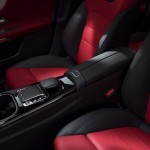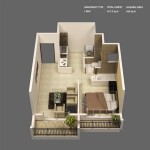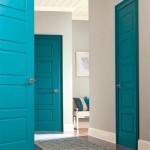What Is Contemporary Style Interior Design?
Contemporary interior design is often mistaken for modern design, but while they share some similarities, they are distinct styles. Modern design, which peaked in the mid-20th century, is a defined and static style characterized by specific design principles and aesthetics that emerged from a particular historical period. Contemporary design, on the other hand, is ever-evolving and reflects the current trends and styles of the present moment. It is a dynamic concept, adapting to what is popular and innovative at any given time. This means that contemporary style in 2024 looks different than it did in 2014, and it will likely change again in the future.
To understand contemporary interior design, it is crucial to appreciate its fluidity. It's a blend of various influences and styles, incorporating elements from modernism, minimalism, art deco, and even hints of traditional design. This eclectic approach allows for a high degree of personalization and creativity. The core principle of contemporary design is to create spaces that are comfortable, functional, and aesthetically pleasing, reflecting the current sensibilities of design and lifestyle.
Several factors contribute to the shaping of contemporary design. Technological advancements, societal shifts, environmental concerns, and cultural trends all play a role. As technology continues to evolve, the integration of smart home features and advanced materials influences design choices. Growing awareness of sustainability promotes the use of eco-friendly materials and energy-efficient solutions. Changes in lifestyle, such as the rise of remote work, also impact interior design, leading to the creation of versatile and adaptable living spaces.
Given its dynamic nature, pinpointing definitive characteristics of contemporary design can be challenging. However, there are several recurring elements that frequently appear in contemporary interiors, providing a general framework for understanding this style. These elements include the use of neutral color palettes, clean lines, natural light, open spaces, and an emphasis on texture.
Key Characteristics of Contemporary Design
Contemporary design prioritizes a sense of calm and serenity, often achieved through a carefully curated selection of elements. The following are some of the fundamental characteristics that define contemporary interior design:
1. Neutral Color Palettes: A defining aspect of contemporary design is the use of neutral color palettes. Shades of white, beige, gray, and black serve as the foundation for most contemporary spaces. These colors create a sense of sophistication and tranquility, allowing other elements to stand out. While neutral colors dominate, bolder accent colors are frequently incorporated to add pops of visual interest. These accent colors can appear in artwork, accessories, or even furniture pieces. The juxtaposition of neutral tones with strategic pops of color creates a balanced and harmonious visual experience.
The preference for neutral colors also stems from the desire for versatility. Neutral backgrounds allow for easier adaptation to changing trends and personal preferences. It becomes simpler to update the look of a room by swapping out accessories or artwork rather than undertaking a complete overhaul of the color scheme.
2. Clean Lines and Minimalism: Contemporary design embraces clean, uncluttered lines and a minimalist approach. Furniture and architectural elements are characterized by their simplicity and lack of ornamentation. Straight lines, geometric shapes, and smooth surfaces are prevalent. This emphasis on simplicity extends to the overall layout of the space, with a focus on functionality and efficiency. The goal is to create a sense of order and spaciousness, avoiding unnecessary clutter and visual distractions.
This minimalist aesthetic does not equate to a lack of personality. Instead, it allows for a greater appreciation of individual pieces and the overall composition of the space. Each item is carefully selected for its form, function, and contribution to the overall design. A well-placed piece of art, a unique lighting fixture, or a sculptural element can become a focal point in a contemporary interior.
3. Natural Light and Open Spaces: The use of natural light is paramount in contemporary design. Large windows, skylights, and open floor plans are frequently employed to maximize the amount of natural light that enters the space. Natural light enhances the sense of openness and airiness, creating a more welcoming and vibrant environment. Window treatments are typically minimal, such as simple blinds or sheer curtains, to avoid obstructing the natural light flow.
Open floor plans, which combine living, dining, and kitchen areas into a single continuous space, are a common feature of contemporary homes. These layouts promote a sense of connectivity and facilitate social interaction. They also contribute to the overall feeling of spaciousness and freedom that is characteristic of contemporary design. The strategic placement of furniture and the use of area rugs can help to define different zones within an open floor plan without creating physical barriers.
Materials and Textures in Contemporary Design
Contemporary design places significant emphasis on the use of materials and textures to add depth and visual interest to a space. The selection of materials often reflects a blend of natural and manufactured elements, creating a balanced and harmonious aesthetic.
1. Natural Materials: Natural materials such as wood, stone, glass, and metal are commonly used in contemporary interiors. Wood flooring, exposed brick walls, and stone countertops are all examples of how natural materials can be incorporated into the design. These materials add warmth, texture, and a sense of connection to the natural world. Sustainable and eco-friendly materials, such as reclaimed wood and bamboo, are increasingly popular choices for contemporary designers who prioritize environmental responsibility.
2. Manufactured Materials: In addition to natural materials, contemporary design also embraces the use of manufactured materials such as concrete, steel, and glass. These materials can be used to create sleek, modern surfaces and architectural details. Polished concrete floors, stainless steel appliances, and glass partitions are all examples of how manufactured materials can be incorporated into the design. The combination of natural and manufactured materials creates a sense of balance and contrast, adding depth and visual interest to the space.
3. Textural Elements: Texture plays a crucial role in contemporary design. The strategic use of different textures can add depth, dimension, and visual interest to a space, even within a neutral color palette. Examples of textural elements include woven rugs, plush throws, textured wall coverings, and sculptural objects. The juxtaposition of smooth and rough textures, such as pairing a sleek leather sofa with a woven throw blanket, creates a dynamic and engaging visual experience.
Furniture and Accessories in Contemporary Design
Furniture and accessories in contemporary design are carefully selected to complement the overall aesthetic. Pieces are typically characterized by their clean lines, simple forms, and functional design.
1. Functional Furniture: Contemporary furniture prioritizes functionality and comfort. Sofas and chairs are often upholstered in neutral fabrics and feature clean, streamlined silhouettes. Multifunctional furniture, such as storage ottomans and convertible sofas, is a popular choice for maximizing space and efficiency. The emphasis is on creating comfortable and inviting spaces that are well-suited for both relaxation and entertainment.
2. Statement Pieces: While contemporary design favors minimalism, it also allows for the inclusion of statement pieces that add personality and visual interest to the space. These statement pieces can be anything from a bold piece of artwork to a unique lighting fixture or a sculptural object. The key is to select pieces that complement the overall design aesthetic and contribute to the overall composition of the space.
3. Minimal Accessories: Accessories in contemporary design are typically kept to a minimum. The focus is on quality over quantity, with carefully selected pieces that enhance the overall aesthetic. Artwork, plants, and decorative objects are strategically placed to add pops of color, texture, and visual interest to the space. Clutter is avoided, and each item is chosen for its form, function, and contribution to the overall design.
In summary, contemporary interior design is a dynamic and evolving style that reflects the current trends and sensibilities of design and lifestyle. It is characterized by its use of neutral color palettes, clean lines, natural light, open spaces, and an emphasis on texture. It embraces a blend of natural and manufactured materials, functional furniture, and minimal accessories. By understanding these key characteristics, one can create contemporary spaces that are comfortable, functional, and aesthetically pleasing.

Contemporary Design Style And The Essentials To Master It Décor Aid

Contemporary Vs Modern Interior Design Everything To Know Décor Aid

Contemporary Interior Design Style All You Need To Know Beautiful Homes

Contemporary Design Style And The Essentials To Master It Décor Aid

Contemporary Design Style 101 Everything You Need To Know About

10 Contemporary Interior Design Ideas Of 2024 Designcafe

5 Key Elements That Define Contemporary Interior Design Avaato Miami Based Firm

Difference Between Modern Vs Contemporary Interior Design

Contemporary Design Style And The Essentials To Master It Décor Aid

Contemporary Interior Design Style For Houses And Apartments
Related Posts








